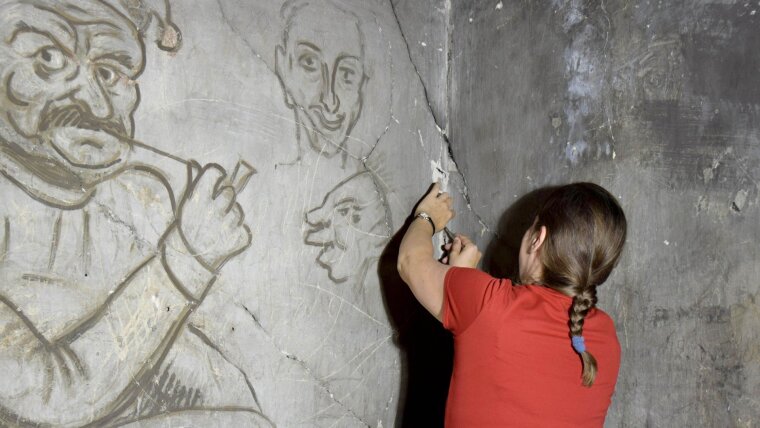
Published: | By: Axel Burchardt
Exactly 200 years ago, on 30 July 1822, one of nine “detention cells” that then existed at the University of Jena is said to have been “decorated” in a single day. According to the oft-told story, imprisoned student Martin Disteli painted numerous scenes, mostly caricatures of people, on the walls of the approximately 15-square-metre cell, using blood, excrement and other organic materials. However, a recently started restoration of the historical cell has already shown this is only a legend, which means that part of Jena University’s history will have to be rewritten.
Thuringia’s only historical student detention cell
For a long time, Jena University’s former student prison – the “Karzer” or detention cell – was only opened on special occasions. The fear was too great that visitors might damage the rare paintings through their perspiration or by touching them. “This is because it’s the only historical student detention cell in Germany that was completely painted by a single artist,” says Dr Babett Forster, Head of the University’s Custody. But she and her colleague Gina Grond were keen to make this historical gem more accessible to the public. Restoration with suitable protection of the paintings would make this possible. Once the Custody had obtained funding from the Thuringian State Office for the Preservation of Monuments and Archaeology, the Association for Jena’s City and University History, the Friends and Patrons of Jena University, and the University’s own funds, the restoration could begin.
Analysis disproves legend
The freelance restorer and detention cell specialist Katharina Heiling was commissioned to do the restoration. Before the practical work began in Jena, she sent some material samples from the detention cell to a specialised laboratory in Prague. The analysis proved that neither blood nor excrement had been used for the artwork, but rather paints that were common 200 years ago. These were presumably made by Disteli himself from the naturally occurring earth pigments yellow and brown ochre, and the binding agents linseed oil and lime casein, which disproved part of the legend.
And Katharina Heiling was also able to consign to the realms of mythology the story that Disteli had painted the detention cell as a prisoner in a rapid operation. Surface cleaning allowed an unimpeded view of the paintings. This enabled Heiling to prove that instead of a fresco technique painted quickly onto the wet lime plaster, Disteli had worked in a secco technique, painting onto already dry plaster. What is striking is the use of different binding agents on the various walls, which makes the paintings on the north wall differ greatly from the others. It is now assumed, says Forster, that the Jena student Martin Disteli was not locked up, but was on a visit and took the opportunity to paint the previously blank walls of the cell. The date, 30 July 1822, probably referred to when the work was completed.
New paintings found
The work of the Swiss painter and political cartoonist Martin Disteli is a work of art that should be preserved. Heiling is going to stabilise the walls and the paint, clean the paintings and touch up missing areas. “Marks that seem to be due to the detention cell having been used will not be restored,” she says. A particular challenge will be a finding Heiling made during an examination with UV radiation of the fourth wall, which has so far been monochrome. The short-wave radiation can cause materials of a work of art to fluoresce, thus enabling a more differentiated perception of the painting materials used. As a result of this investigation, it was proven that there are other paintings behind layers of paint that were added later. “The wall was painted over at a later date,” says Heiling.
All those involved hope to have completed the restoration by Open Monument Day in September and to be able to open the freshened-up and preserved detention cell to the public from time to time. And even if this deadline cannot be met – as is so often the case with such projects – one thing is certain, says Babett Forster: “The goal of the extensive work is to be able to show this university treasure to interested members of the public on a regular basis.”
Fürstengraben 18
07743 Jena Google Maps site planExternal link